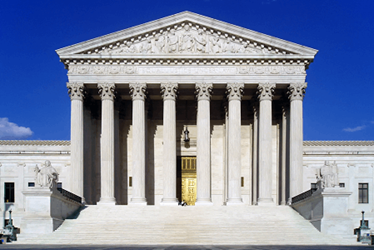The Supreme Court's Upcoming Review Of IPR Constitutionality — A Biopharma Perspective
By Eli A. Loots, Ph.D., Kerry S. Taylor, Ph.D., and Nathanael R. Luman, Ph.D., Knobbe Martens Olson & Bear LLP

On June 12, the Supreme Court granted certiorari on the question of whether inter partes review (IPR) is unconstitutional. See Oil States Energy Services, LLC v. Greene’s Energy Group, LLC, Case 16-712 (U.S. 2017). While this is a change from the previous two denials of cert regarding IPR, one thing is clear: The fate of IPRs will be decided during the upcoming October 2017 term. This article provides advice for dealing with the dynamic and evolving biopharma patent litigation landscape while we wait for the Supreme Court’s decision on IPRs, which is due by June of 2018.
Current Role Of IPRs In Biopharma
IPR provides an adversarial process for challenging patents at the U.S. Patent Office. As of earlier this year, there were over 50 IPR petitions reportedly on file challenging patents relating to the large molecule biopharma space, including various platform cases. These petitions have been reportedly filed on molecules such as rituximab (filed by Celltrion and Pfizer), adalimumab (by Boehringer Ingelheim and Coherus Biosciences), trastuzumab (by Mylan, Hospira, Celltrion, and Pfizer), bevacizumab (by Hospira), etanercept (by Coalition for Affordable Drugs), abatacept (by Momenta Pharma), and natalizumab (by Swiss Pharma Int.). Thus, a wide variety of challengers have pursued IPRs across a wide variety of biopharma products.
IPRs have been relatively popular in the biopharma space because these proceedings provide a mechanism for challenging the validity of a patent within a relatively predictable time frame (one year from institution) using a lower standard of unpatentability than district court litigation. It can therefore be faster and easier to remove a patent via an IPR than through district court litigation. Perhaps even more importantly, an IPR petition can be filed independent of any of the more traditional questions of standing, allowing for a challenger to clear a path forward at a relatively predictable point in time, independent of their actual biopharma product. To date, IPRs have resulted in a number of biopharma patents being held unpatentable, especially where the prior art is clearly and cleanly on point. But the Supreme Court’s upcoming determination of IPR constitutionality threatens to take away IPRs as an option for challenging patents, raising short-term and long-term strategic litigation considerations for biopharma companies.
Short- And Long-Term Strategic Considerations
If you are a party to an IPR, you should recognize that the Patent Office is unlikely to stay the IPR to wait for the Supreme Court’s determination. This means that you will likely need to continue litigating the IPR. If you are a patent owner in an IPR, you should consider filing a notice reserving your rights to contest the constitutionality of the proceeding pending the Supreme Court’s determination. Furthermore, if you receive a decision holding your patent to be unpatentable, you should consider keeping an appeal pending until the Supreme Court determines the constitutionality of IPRs.
If you are considering filing an IPR petition between now and when the Supreme Court issues its determination, there are several factors that should weigh into your decision. First, if you have already received a complaint for patent infringement, you still have a one-year deadline to file an IPR petition, and this deadline is not delayed or suspended while waiting for the Supreme Court’s determination. Second, be careful to weigh whether an IPR petition should be filed before the Supreme Court’s determination against the realities of your product development timeline, the need to clear competitor patents, and other competition variables. Third, IPR petitioners should recognize that a determination by the Supreme Court that IPRs are unconstitutional may impact other proceedings at the Patent Office or in court. Therefore, you should carefully evaluate available options and develop a customized strategy to fit the needs of your biopharma product.
To the extent settlements and/or licensing of biopharma patents are negotiated before the Supreme Court’s determination, the settlement value of an IPR may be discounted in some situations. Thus, the timing of strategic negotiations should be carefully mapped out over the next year. Where possible, agreements should take into account the open question in front of the court as well.
While the above analysis outlines some aspects relating to strategic choices over the next year, there will be numerous long-term implications from the Supreme Court’s determination. For example, while the court recently indicated that, at least in some situations, the patent dance is optional for biosimilar producers, the question remains whether biosimilar producers will take this option for later-generation biopharma products where there are very extensive patent families with significant patent term remaining. In such situations, a biosimilar producer may have wanted to avoid the patent dance by clearing perceived threats through an IPR. If IPRs are no longer available, we may see more biosimilar producers participating in the patent dance.
Additional Patent Office Options
Even if the Supreme Court determines that IPRs are unconstitutional, there are other options available for challenging patents and applications at the Patent Office. These options include, for example, ex parte reexamination, third-party submissions, and filing a protest against a pending application. However, these options do not allow ongoing third-party involvement, and are therefore less likely to be as popular as IPRs have been for patent challengers in the biopharma space.
Conclusion
The Supreme Court’s determination on the constitutionality of IPR will either maintain or remove IPR from the patent litigation landscape. Any pending IPR or strategic decision on whether to file an IPR in the biopharma space should take into consideration the variables outlined above. Regardless of the outcome of the Supreme Court’s determination, the industry should have a much clearer idea whether IPRs will continue to play a role in biopharma litigation by June of 2018.
About The Authors:
 Eli A. Loots, Ph.D., is a partner in Knobbe Marten’s San Francisco office. Kerry S. Taylor, Ph.D., and Nathanael R. Luman, Ph.D., are partners in the firm’s San Diego office. Dr. Loots regularly counsels biologics and biosimilar clients regarding IPRs. Dr. Taylor leads the firm’s efforts in IPRs in the life sciences and biotechnology industries. Dr. Luman has represented biotechnology and chemical companies in several IPRs.
Eli A. Loots, Ph.D., is a partner in Knobbe Marten’s San Francisco office. Kerry S. Taylor, Ph.D., and Nathanael R. Luman, Ph.D., are partners in the firm’s San Diego office. Dr. Loots regularly counsels biologics and biosimilar clients regarding IPRs. Dr. Taylor leads the firm’s efforts in IPRs in the life sciences and biotechnology industries. Dr. Luman has represented biotechnology and chemical companies in several IPRs.
Supreme Court building image credit: CC-BY-SA-3.0/Matt H. Wade at Wikipedia
